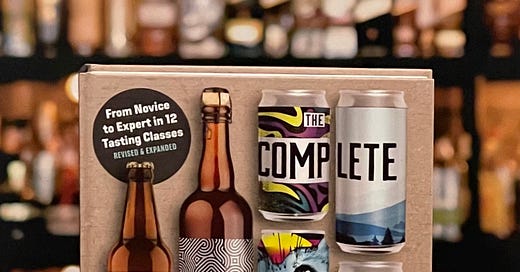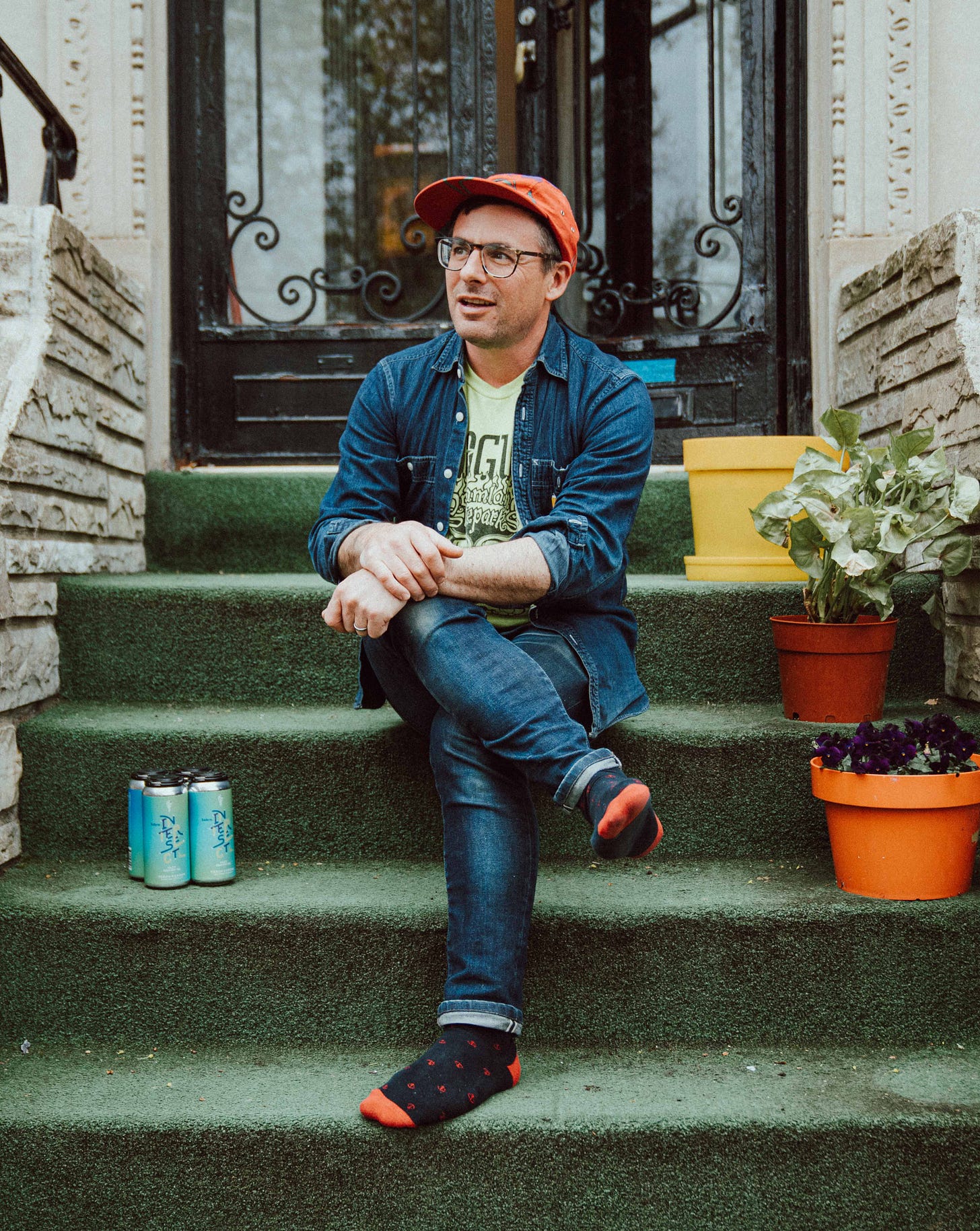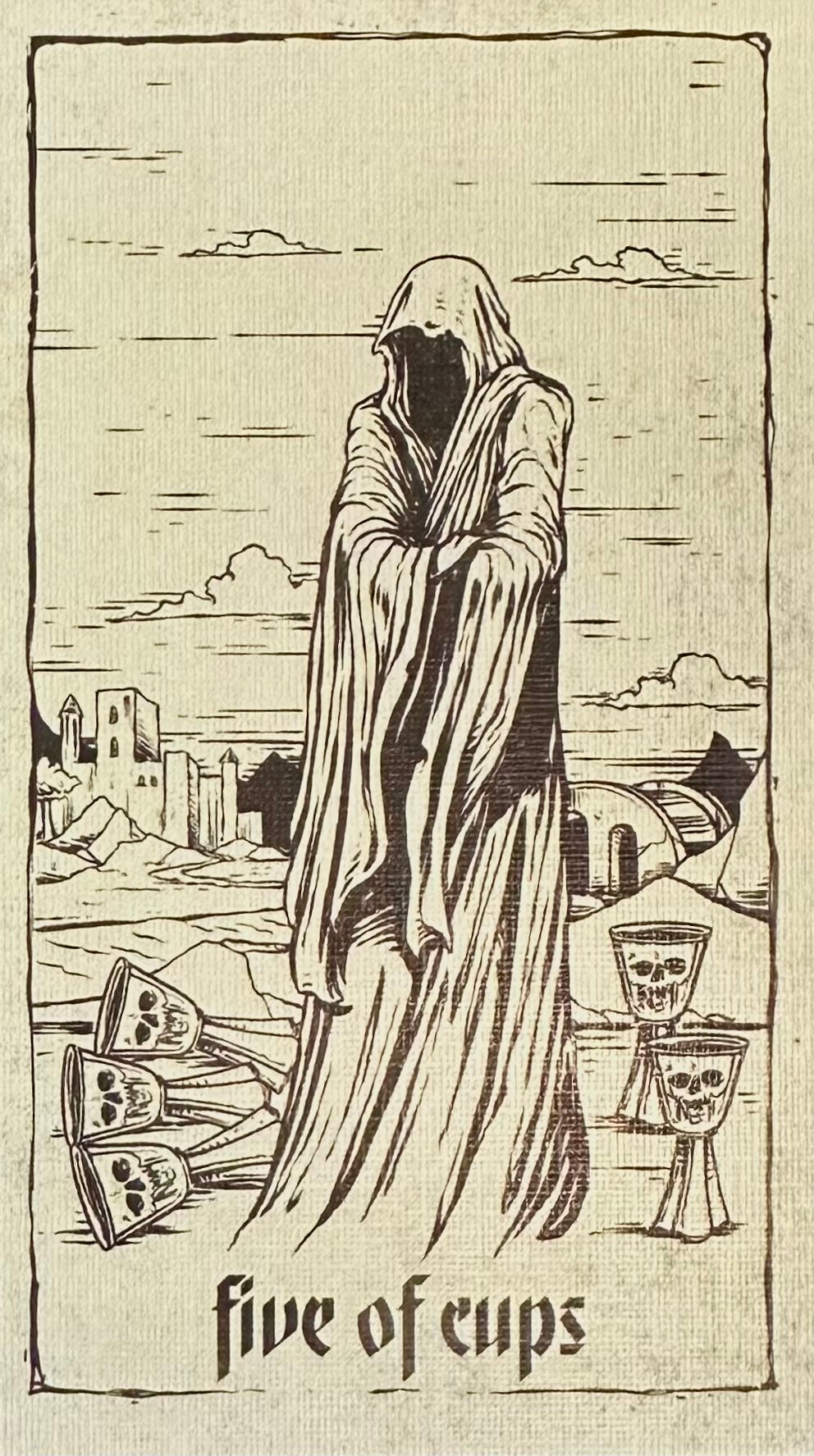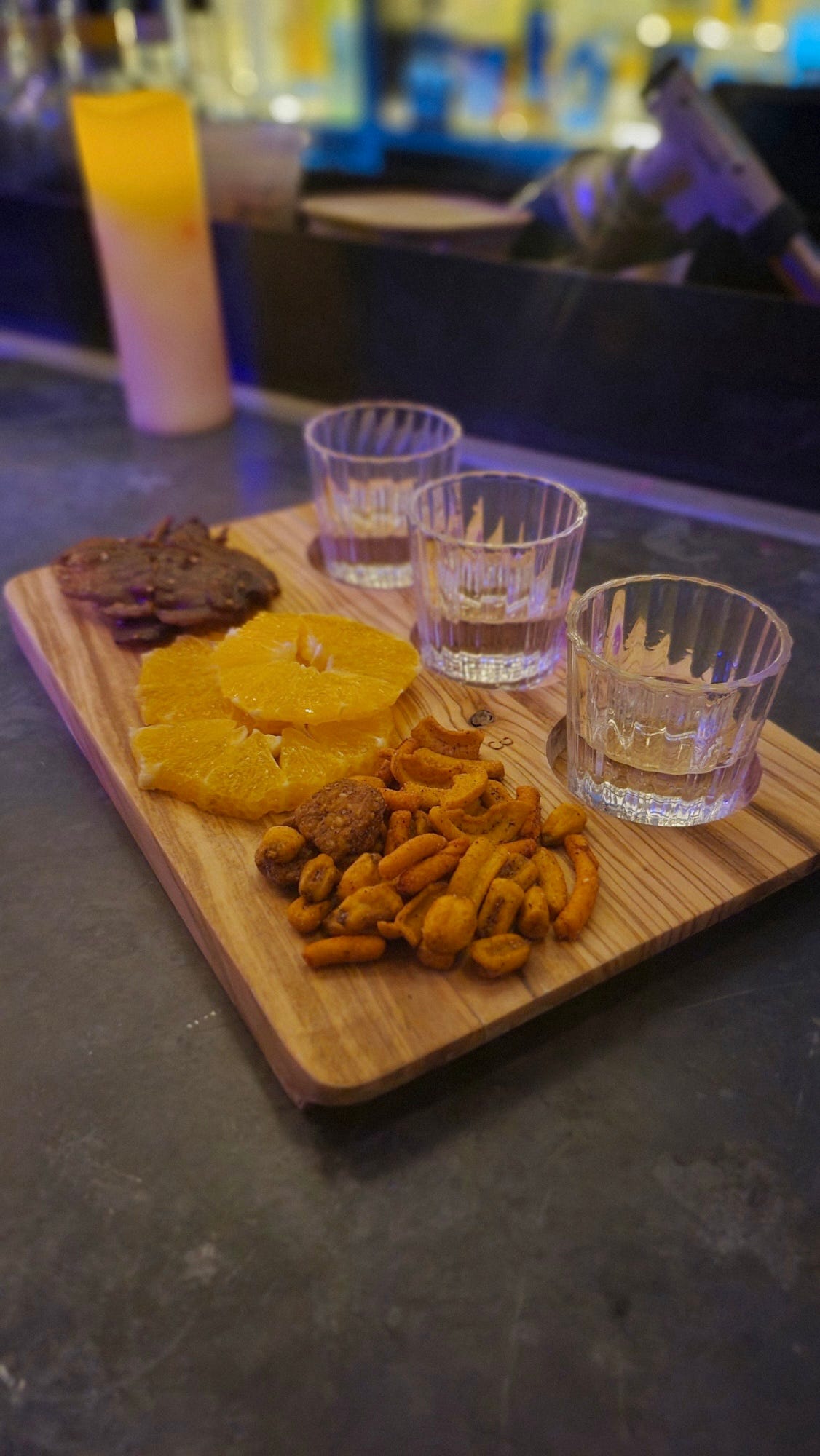92. The Complete Beer Course, Updated: How an Author Stays on Top of a Changing Industry
An interview with Joshua M. Bernstein about second editions and craft beer "then" and "now"; plus a new feature for paid subscribers and tarot for turning frustration into action.
The Complete Beer Course Gets an Update
When I heard Joshua M. Bernstein’s “The Complete Beer Course” was getting a second, updated edition, the ol’ curiosity wheels began to turn. This update means “The Complete Beer Course” joins essential texts like Randy Mosher’s “Tasting Beer” and Jeff Alworth’s “Beer Bible” in the territory of comprehensive, expansive guides to craft beer, studied by professionals and regularly thumbed through by enthusiasts, that have gotten a second edition to reflect how much craft beer grows and changes and how fast it does so. What does an update of this magnitude entail? When and how does the author know it’s necessary? What are the biggest takeaways that crystallize when looking at craft beer then (first-edition times) versus now (second-edition times)? And what does that say about the industry?
Forever generous with his expertise and experience, Josh walked me through the process of updating a behemoth beer manual like “The Complete Beer Course,” with all kinds of interesting resulting insights. Take a look, and if you haven’t yet, preorder your second edition. If you’re in NYC, Josh is having a release party at KCBC *tonight* (where it just so happens to be Lager Appreciation Month!). Info and tickets here, use code BEERANDBOOKS for $5 off the beer-and-book package.
When did you actually start working on the first edition of “The Complete Beer Course?”
The first edition I started working on in 2012, which was pretty soon after my first book “Brewed Awakening” came out. “Brewed Awakening” came out, I think, November of 2011. And then pretty much after I got done with that and got done with the book tour, the publishers were like, “And now we want you to do this book.”…The publishing industry really tries to build authors and catalogs at times, and so they used “Brewed Awakening” as a way to introduce me. And then the big thing when we got there was “The Complete Beer Course.” “The Complete Beer Course” was supposed to be the beer world’s answer to Kevin Zraly’s “Windows on the World Complete Wine Course”—it’s been one of the bestselling wine books of all time…and it’s still in print today, it’s still being updated. [My publishers] handed me “Windows on the World” and were like, “Do this for beer.” It just wasn't quite this one-to-one transporting over. It wasn’t like I opened up the book like, “Okay, page one, let's do this for beer too,” just because…the industries were just so different, how we worked out our appreciation for these things was so different. So I really had to create this…and it really became, I think, similar in name only, in a sense. I mean, the educational imperative was really running through both books, but I just had to rethink what was useful for beer and what would people want to learn about.
What was the craft beer scene like then—what are some of the biggest, clearest, most overarching differences between then and approaching this book now?
When I think back to 2012, I mean, it was really this era of the brewmaster-end-all-be-all, you know what I mean? So…all the information and all the beer knowledge came forth from them. It was kind of wild. If you think about it back then, the brewmaster as celebrity, that concept was huge. You almost needed these figureheads, I think, to be able to talk about what was happening…to communicate vast changes [in beer]. And there was a huge factor of showmanship back then, too, showing what was possible with beer. Back then you could dump pretty much anything into a brew kettle, and people would be like, “Oh my god, I can’t believe it. That’s so insane. I never knew the beer could be like this.”…It was just this era of just trying to get people's attention. And I think back then it made a lot of sense. You almost had to shock people to show them that there could be something so drastically different from the lagers they were consuming.
And so back then, it was just sort of this idea that all knowledge came forth from a handful of concentrated people. All these crazy things that were happening out there, it was this Brew Dog era. “Let’s make a 40% beer. Now, 50%.” It was a very big P. T. Barnum-esque moment. I think for a writer’s perspective, there were all these great narratives of these people going David-versus-Goliath, and if you fast forward to today, you realize that everything wasn't quite as cut-and-dried. Everything is really blunt in the ways we talked about beer back then because we were so caught up in this idea of promoting the idea of how beer could be so different and all these rebels and revolutions and iconoclasts…we didn’t really talk too much about the industry itself. It was more focused on these crazy achievements that people were doing out there and it felt like nobody could do any wrong back then, and we didn't really question people’s business practices. We didn’t question the people…But if I fast-forward a decade to nowadays, I mean…I'm not quite so naïve with some of the stuff that has happened there.
I'm a lot more clear-eyed about the beer industry…Everything that we fought against, like, “fizzy lager is bad and IPA is good,” things aren't quite as black-and-white as they used to be. There are a lot of gray areas. And there’s some good in the gray areas, and there’s some bad in the gray areas, too…so, redoing the book, I wanted to soften some of my “Rah, Rah, Sis, Boom, Bah, craft beer is the best of everything out there!”…I think we had this line where everything was just good-versus-bad, big-versus-small. And things aren't quite so simple as they used to be anymore.
[Also,] back then in 2013, your bodegas weren't filled with better beer. [To explore different beer] you wanted to go to different cities. Beer pilgrimages were big, so you'd book a flight to your Portland, Oregons or your San Diegos…and with the pandemic [that changed]. I started the revision in 2019, and then when the pandemic hit, it really made no sense to talk about going places when I didn't really know when you could again. It also didn’t make a lot of sense to talk about beer festivals…I really wanted to put the focus back on the people. Back then, 2013, we really talked about these figurehead head brewers we really used to serve our sound bites…but there’s just so many people within the context of the industry like canning operators, people that run quality control labs, sales reps…I really want to give a voice to these people that are in the industry and show people that beer is more than just one single person, that breweries are miniature factories and everybody has different roles, and getting that beer into your hand requires a lot of hard effort and a lot of [teamwork].
Has anything actually stayed more or less the same?
You would think that things have stayed static, but…I try to have this sort of national vocabulary of beers to try, right? You want people to be able to try things that are going to be widely accessible, that are going to have a flavor profile that most everybody’s going to be able to try without having to wait in line for two hours or whatever. So, I was like, “Okay, New Belgium Fat Tire is a bedrock beer. You have a great example there of an amber ale.” And then after the book went to print, they changed the recipe for Fat Tire. Even things I thought were going to be kind of immutable and never changing ended up changing after we went to print, which is always maddening. It was just a good reminder that nothing is sacred anymore, that nothing is going to be eternal…It was just crazy that I think my publishers originally thought [the update] was going to be kind of like, “Polish it up with a few new pictures in the book, and you’re done.” But just almost everything that we knew really changed. A number of hop varieties exploded, yeast strains exploded, non-alcoholic beer took off in a big way…I had to address all of these things.
What responsibility does the author of this kind of book have when they’re in an industry like craft beer that is changing and evolving so much? What sort of duty is there to keep revisiting and updating?
I think you want to keep your book as current and as useful to people as humanly possible. And that’s something that’s going to date itself. Anything that you print…is going to be outdated eventually, that’s just the reality of it all. But I think there are ways you can approach this to make beer feel more timeless, that you can make a story more impactful. As I talked about a bit earlier on, I really tried to move away from suggesting you go to these fixed places in time and fixed locations, and really up the people quotient of the book.
There is also a larger aspect where…in the beer industry, we went from this moment where we didn’t care about beer in modern America to caring way too much and everything got really overwhelming and really turned a lot of people off. Any sort of subgenre, people can get really fixated on it and maybe turn [other] people off. I think craft beer did a great job in the beginning of bringing people in, and then it just got too kind of insider for a long period of time. The trading and the waiting in line and everything like that. And we kind of lost focus of the fact that what was really important is the people behind it. It was my job, I think, to recenter how we access the stories of beer that we’re able to tell. I don’t want anybody to pick up the book and be like, “Ah man, I’m never going to make it to that brewery.” And you probably won't, and that’s okay: there are a million other stories where I think where you can learn so much more.
You’ve also got to find the right place to center your book…I’m never going to out-taste Randy Mosher…or out-history Jeff Alworth…but I tried to find this line. It’s not “beer for dummies.” It’s this fine line of the book becoming very approachable to people to bring hopefully more people into the beer world, and to be able to confidently talk about your styles…you always ask who the audience is, and it’s become such an interesting educational resource, more people are using it as a textbook in colleges and classes, and it’s become, I think, a staple at taprooms behind the bar to let people talk about the difference between a helles and a pilsner…So, my responsibility ultimately is to make sure everyone’s talking about beer in the right way, that we share this language, and get more people excited about what beer is and what it can be.
New Feature for Paid Subscribers
This week kicks off a new mini-newsletter companion piece for paid subscribers. Huzzah! It’s called “Hangover Cure,” and to borrow from the intro of the first issue:
After all that beer talk, I figured it was worth taking a break and highlighting some non-beer things we can just get some joy or learning or feels or all of the above from. It’s something that comes up a lot when we talk about avoiding burnout: step away from the “all beer, all the time” and embrace other things you love and want to learn more about. Doing so helps you keep your sanity, is just plain good for you, and can even inform your work and inspire your creativity. You do not need an excuse to keep your free time free, but if you’re like me and can’t stop rationalizing it…there you go.
So, every week, we’ll step away from the booze talk and give our heads a rest with TV, movies, books, music, podcasts, and more—say, two-to-five things, each week. Sometimes these recs will be hot off the presses, sometimes they’ll be old and under the radar. And you are definitely invited to comment with whether you love them or hate them, and with your own recs!
Hangover Cure issues will go out on Fridays, just in time for some weekend reading, listening, viewing, etc. After a few weeks, I’ll make them public, but if you want to catch these as they drop, consider upgrading to a paid subscription! You get other fun perks like a personalized tarot reading (by the way, if you’ve recently signed up for a paid subscription and want your tarot reading, don’t forget to email huggingthebar@gmail.com!) and free swag, and you’re supporting Hugging the Bar.
Beer Tarot!
This week, I pulled the Five of Cups.
Cups is the suit of love, emotions, and relationships, and the Five of Cups in particular speaks to regret, failure, and disappointment. Fun!
This Gloomy Gus shows up when we’re feeling bummed out by the way something has gone recently. You didn’t get that job, or a relationship ended, or a project just didn’t go how you anticipated, or…you went to CBC expecting meaningful steps toward inclusivity, maybe, idk. The major message the Five of Cups wants to deliver to you is that you may be feeling a little stuck in that disappointment, and that wallowing never really proves to be all that productive. If you’re holding a grudge, the only person you’re really hurting is yourself. You’re keeping all this negativity bottled up and there’s almost no way that’s not bleeding into other areas of your life—it’s sabotaging your happiness, wellness, fulfillment, and success in other places, and the target of the grudge might even be blissfully unaware of it. The goal here is to turn the anger or sadness you have about whatever situation you’re dealing with here into energy that propels you forward on a mission to help change it, and/or heal yourself.
I’d throw in my own two cents here, which is that you’ve got to do this on your own timeline. Sometimes, the tarot can feel a little judgy, tbh! You do obviously and absolutely deserve time to wallow! Take it, feel those feelings—rushing through them and shoving them somewhere they’re not ready to go before they’re ready to go anywhere is just as unhealthy as sitting in them for too long. When you’re ready, though, let them go and convert them into motivation for whatever your healing or recovery or change process looks like.
Let’s stick with the CBC example here, because this is “beer tarot”—if you are dealing with disappointment around the BA’s failure to make members of the LGBTQIA+ community feel safe and supported in Tennessee and around a pervasive ignorance of diversity and inclusion endeavors from the overall industry, it’s flat-out wrong for anyone to tell you how to feel your feelings and on what timeline. But, again, when you are ready, let those feelings fuel you long-term—as we talked about last week, don’t let your anger die out when it could keep you speaking up and speaking out all year round, which is what is so desperately needed from more members of the craft beer community. So, I’d say the Five of Cups energy isn’t letting negative feelings fade, but converting them into something else, something new, something better. Ferment them, I guess? This week’s beer tarot pairing, then, is the BA’s survey on this year’s CBC. If you went, make sure you fill this out—it’s an easy way to channel those feelings into speaking up.
This Week’s Boozy Media Rec
Have you started listening to Dave Infante’s podcast for VinePair, Taplines? Each episode deep-dives into another pocket of modern American beer history, and I am here for it. This podcast sits right in that sweet spot of not being just another beer podcast, but of really nicely rounding out the beer podcast options available with content that is less gushy brewer interviews, more investigating the how’s and why’s of beer, looking at how we got where we are, why it matters, and what it might mean for beer in the present and future. I was just riveted by episode two, The Birth of Line Culture, on which Dave interviews Natalie Cilurzo about the beginning of Pliny the Younger and its ensuing cult status. The story of that first day that people started lining up for the release has me incredibly frustrated that most people don’t give af about craft beer, because MAN would it be a good movie. Even if you know the story, hearing Natalie tell it here is such good podcasting. (Natalie is a natural storyteller!)
Ex-BEER-ience of the Week
I really have not had much beer at all this week, being that I really needed a break after CBC. So, instead, I’m going to shout out a mezcal bar we went to last night, The Cabinet, in Alphabet City. They’ve got hundreds of mezcals, and what sets them apart is how much information you get with a flight. The bartender was super knowledgeable and actually walked us through how a Jabali, sotol, and pulque were made. I have gotten mezcal flights before at other bars and had to ask what the brands even were. So, this really stood out—I learned tons and recommend this bar very, very much if you’d like to drink delicious mezcal and mezcal cocktails and further your mezcal knowledge journey. (There are also great tacos!)
Until next week, here’s Darby taking in the sunset.









